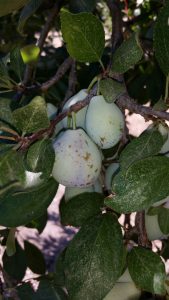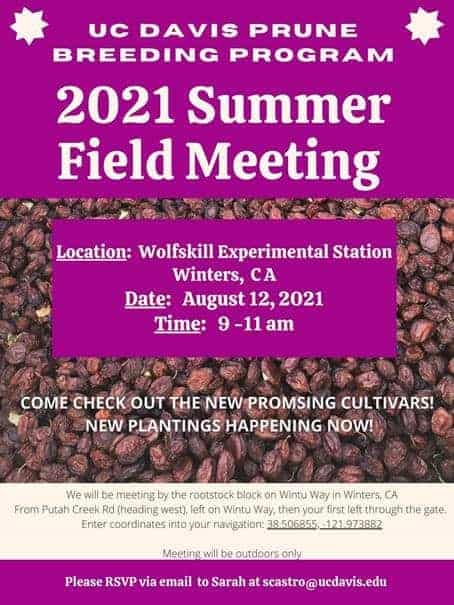Orchard Notes: June 2021
2021 Crop Estimate
With summer comes the question of crop size for the industry. View the Press Release that was issued to global media and trade regarding the 2021 crop estimate. The Executive Committee, Board, and PMC unanimously agreed on an estimated 75,000 tons for the 2021 crop. Executive Director Donn Zea spoke with Ag Net West about the quality of this year’s crop, current market conditions, and the impact of COVID-19 on the California Prune industry.
Summer Orchard Considerations
Franz Niederholzer, UCCE Farm Advisor, Colusa, Sutter and Yuba Counties
Luke Milliron, UCCE Farm Advisor, Butte, Glenn, and Tehama Counties
Katherine Jarvis-Shean, UCCE Farm Advisor Sacramento, Solano & Yolo Counties
With summer in full swing and harvest quickly approaching, the UC Extension team compiled orchard considerations for the next few months. Please note that the following are general recommendations intended to help you keep track of regular practices in a busy time; the optimal timing for management practices may vary based on specific location and conditions.
June
- Pest & Disease Monitoring: Continue monitoring for aphids and rust.
- Spider mites: Begin scouting by checking two different sections of the orchard each week. Spend about five minutes in each section, checking 2-3 leaves (some inside and outside of the canopy) on 10 trees. Look for spider mites and predators (predaceous mites and sixspotted thrips). Treatment decisions should be based on the population levels of both mites and predators. If more than 20% of leaves have mites, but less than 50% of the leaves have predators, treat for mites. If more than 60% of leaves have mites, treat them even if most leaves have predators. For more on mites, see the UC IPM Page on Webspinning Spider Mites.
- Irrigation Management: To avoid excessive vegetative growth and associated pruning costs, maintaining a mild to moderate tree water stress with the pressure chamber from late June, through early August reduces shoot growth without slowing fruit sizing. Learn more from our article on Pre- and Post- Harvest Irrigation Management in Prunes.
July
- Start anticipating harvest timing. Once the first healthy fruit in the orchard starts changing color along the suture (see photo below), the fruit should be ready to harvest in roughly 30 days. The UC prune harvest prediction model anticipates harvest in the Sacramento Valley

starting roughly in the last week of August based on regional bloom dates and CIMIS weather station data. The exact date will vary from block to block. Indications are that harvest will be in the second half, not the first half, of August in many prune growing areas. Once the first healthy fruit in the orchard starts changing color along the suture (see photo on right), the fruit should be ready to harvest in roughly 30 days. - Collect leaf samples to gauge what nutrients are sufficient, deficient, and perhaps over-supplied. Adjust the rest of the year’s nutrient management program and next year’s nutrient plan accordingly. Collect from at least 25 trees, gathering 1-2 leaves per tree from non-bearing spurs. A table listing critical levels of essential nutrients in prune appears after this article.
- Brown rot treatment, where deemed necessary based on observations and block history, begin sprays 4-6 weeks before harvest. These preventative sprays are only useful on uninjured fruit. Check with your processor regarding fungicides that are approved for use. The European Union (EU) has banned propiconazole (Tilt®, Bumper®, etc.) use in the EU.
- Apply 20% of your total nitrogen budget in June or July to match the timing of tree demand. Lower rates in June may be prudent if you have a history of hard-to-manage brown rot. See cdfa.ca.gov/fertilizerresearch/docs/Prune_Plum.html for more on the rate and timing of nitrogen applications.
August
- Time your irrigation cut-off to improve dry-away ratios, reduce premature fruit drop and decrease shaker bark damage at harvest. In a drought year like this, trees may be more water-stressed than in wetter years as harvest approaches, so irrigation cut-off might be closer to shake time than commonly done. The pressure chamber is a great irrigation management tool for monitoring tree water stress. July and August, before harvest, stress should be mild to moderate (-12 to -16 bars). Moderate to high tree stress (-16 to -20 bars) may be tolerated a week or two before harvest.
Growers with orchards (or replants) on the new Krymsk 86 (K86) rootstock should take special care to make sure trees are sufficiently dried down before shaking to avoid bark damage. Don’t expect K86 rooted trees to dry down as quickly as those on M29C or M2624. - Monitor fruit maturity development. Fruit is mature when internal pressures are 3-4 lbs. Fruit pressure, not sugars, determines fruit maturity. Fruit over 4 lbs internal pressure has not finished accumulating sugars (dry weight) and will be worth more to a grower if harvested when the internal pressure drops below 4 lbs.
- Field sizing decisions. In the past, many growers regularly ran a 15/16” sizer (AKA sizing chain) to remove garbage and undersized fruit. In recent years, with small and medium fruit now holding much less value than large fruit, some growers have gone to using larger sizers to eliminate smaller fruit. Double-check with your packer about dried fruit value by screen size to help decide if a large sizer (1” or larger) would be a good idea. If you run a sizing chain, regardless of the size, run the receiver belts slowly enough to allow all the fruit to be run directly over the chain and properly sized.
- Clean up the orchard before harvest. Remove dead and dying limbs along with significant (woody) suckers. This will help minimize tree damage during shaking and make for a more efficient harvest.
- Examine fruit pre-harvest to evaluate the damage. Two to four weeks before harvest, evaluate 40 fruit per tree from 25 trees throughout the orchard for worm, scale, and brown rot damage. Fruit can be picked or evaluated on the tree. If you just take samples at harvest, you may miss damaged fruit that dropped early that may indicate room for improvement in your IPM program. An evaluation form is available at: ucanr.edu/PMG/C606/prune-fruitdamagesample.pdf
- Manage post-harvest irrigation to minimize water stress. Following harvest, water stress measured as stem water potential using a pressure chamber should be mild to moderate (-12 to -16 bars). Cytospora canker grows faster in orchards under water stress. Your orchard could show it next year if you ignore or partially ignore your orchard irrigation this fall.
2021 Summer Field Meeting – RSVP Today!
UC Davis Prune Breeding Program
 You are invited to attend a meeting that highlights the new cultivars available from the University’s prune breeding program. During this hands-on meeting, you will tour the UC Davis orchards in Winters, CA, and evaluate the trees for yourself. You will be able to sample fresh and dried ‘Yolo Gold fruit’ as well as other ‘French’ types.
You are invited to attend a meeting that highlights the new cultivars available from the University’s prune breeding program. During this hands-on meeting, you will tour the UC Davis orchards in Winters, CA, and evaluate the trees for yourself. You will be able to sample fresh and dried ‘Yolo Gold fruit’ as well as other ‘French’ types.
Location: Prune Breeding block at Wolfskill Experimental Station, Winters, CA
Date: August 12, 2021
Time: 9-11 am
Directions: We will be meeting by the rootstock block on Wintu Way in Winters, CA: From Putah Creek Rd (heading west), left on Wintu Way, then your first left through the gate. Enter coordinates into your navigation: 38.506855, -121.973882
RSVP to Sarah Castro: scastro@ucdavis.edu
IPA Congress
 California Prunes hosted global industry colleagues for a virtual gathering of the 19th International Prune Association Congress (IPA) this spring. The 2021 IPA Congress brought attendees together for a taste of the Golden State to celebrate the “Global Goodness of Prunes” as the congress theme. International prune industry leaders joined experts in their fields for various sessions that provided a deeper insight into how weather, science, nutrition, and culinary expertise shape the prunes that are consumed around the world. 226 people registered for the event and over 200 individuals attended the congress live.
California Prunes hosted global industry colleagues for a virtual gathering of the 19th International Prune Association Congress (IPA) this spring. The 2021 IPA Congress brought attendees together for a taste of the Golden State to celebrate the “Global Goodness of Prunes” as the congress theme. International prune industry leaders joined experts in their fields for various sessions that provided a deeper insight into how weather, science, nutrition, and culinary expertise shape the prunes that are consumed around the world. 226 people registered for the event and over 200 individuals attended the congress live.
The Orchard Management Panel focused on innovation in the orchard and practices to improve profitability and reduce risk. At the intersection of science, creativity, and calculated risk, you are likely to find growers & specialists testing solutions to myriad orchard challenges and environmental threats in pursuit of high-quality, profitable prune crops. This panel identified & discussed the latest techniques and technologies to meet emerging challenges faced in California, Chile, and France. You can listen to the panel on the Growing the Valley Podcast here.
All of the on-demand session videos can be viewed here.
INC Virtual Conference
The International Nut and Dried Fruit Council (INC) hosted its 2021 INC 3D Online Conference. The conference brought together more than 1,300 industry professionals in the nut and dried fruit industry from over 70 countries around the world. The conference featured highly informative working group sessions for each product under the INC umbrella and prunes were featured in the Raisins, Prunes, and Cranberries Working Group, chaired by Sunsweet Growers president and CEO, Dane Lance.
Watch the panel here: RAISINS, PRUNES & CRANBERRIES
Are you looking for your next farm manager?
The Center for Land-Based Learning trains for a Beginning Farm and Ranch Manager occupation and connects farmers with pre-screened, qualified applicants with transferable skills. It is also available for current employees who have the potential to grow into positions with more responsibility on the farm but just need more education or training. The apprenticeship is structured with at least 3,000 hours of on-the-job training in a diversity of work areas in addition to coursework in ag production and science. The cost to you? Nothing more than hiring an employee.
What’s Your Favorite Summer Prune Recipe?
Does your family add prunes to smoothies, sauces, or salads? Send us your prune pairings and usage ideas, and we will create a recipe to feature on our social media and website. Submit your ideas here: aconsulo@californiaprunes.org